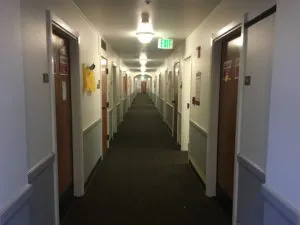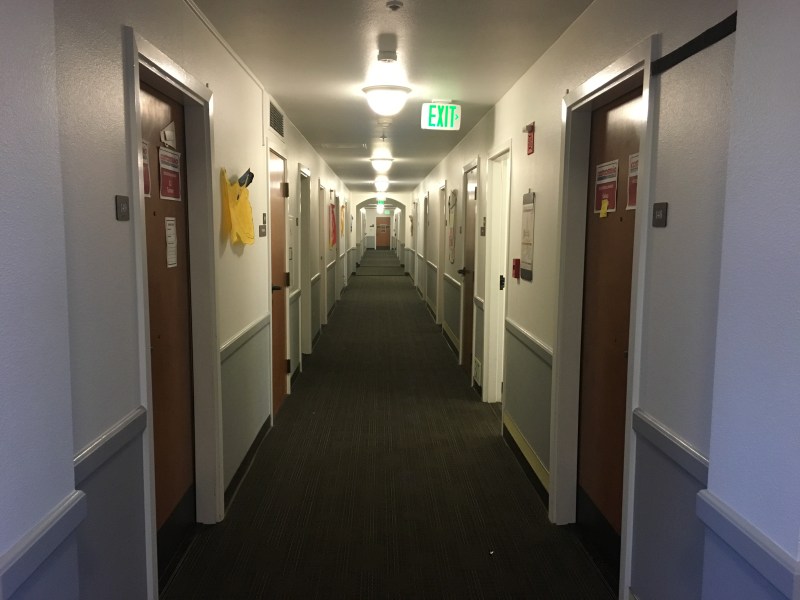In mid-December each year, finals week ends, dining halls close, students’ ID cards no longer unlock the dorms, heating and lights go off and thousands of students return home, wherever that may be. But what about the few students who don’t? For some, going back home is not an option, and it’s up to them to find living arrangements for the next three weeks.

In previous years, the only winter break housing option available has been a subsidized package at the Creekside Inn in Palo Alto for the duration of the 21 day period. In 2017, however, Residential & Dining Enterprises (R&DE) ran a pilot program that allows undergraduates to apply for sublicensing during that period from pre-approved graduate students who live in on-campus housing, in response to a student request. The deadline to apply for these programs was Nov. 27.
The Daily spoke with four students to examine what the experience of finding a place to live outside the dorm is like.
Living in a hotel
For many international students, the cost of traveling makes it difficult to go home over the break. Vinicius Garcia ’20, from Brazil, is one of these students.
“I talked to my [Resident Fellow],” Garcia said. “He showed me this website, SUpost, where Stanford students publish offers for housing. The options were either Mountain View, Palo Alto or Redwood City — which were really expensive — or a graduate student apartment on campus.”
However, when Garcia was investigating these options last year, the University did not allow undergraduates to sublet from graduate students, so he chose to stay at the Creekside Inn, using a stipend he received from the financial aid office to cover the cost of his stay.
“I first wanted to stay around because I thought it would be fun, to see how Palo Alto is and be out of the Stanford bubble,” Garcia said.
But a 20 minute bike ride off campus during a rainy winter left Garcia feeling isolated. All of his friends had gone back home, and he had no way of knowing who the other students staying in the Creekside Inn were.
“I was in a room completely alone,” he said. “The only thing I would do is either eat, watch TV or read,” he said, explaining how he used the time to get ahead on his Structured Liberal Education (SLE) readings for the next quarter.
Living in a hotel for three weeks also meant Garcia was without access to a kitchen.
“When I didn’t want to eat frozen food, I had to go to Palo Alto and eat a $20 meal at a restaurant,” he said. “And for me that was not the most optimal possibility.”
When winter quarter finally began, Garcia was relieved.
“I remember I was really, really happy,” he said. “I’ve never been so alone and so lonely for such a long period of time, so going back to my room to see my friends that was something that I really needed. It was kind of a sad time for me, during Winter Break.”
This year, Garcia stayed with a friend who lives in Delaware, again using stipend funds from his financial aid package to cover the costs of his travel.
“I could’ve asked friends [the last time] but I didn’t know how to approach them and make this request,” Garcia said. “It’s not a minor thing, because I’d be living in their home for almost a month.”
Parimarjan Negi ’18, an international student from New Delhi, India, also stayed at Creekside Inn during a previous winter break. Negi was working at a psychology lab in Jordan Hall, a job he had held during the school year and had wanted to continue.
For Negi, the experience of working on campus during a break was totally unlike working during the year.
“It’s very different from when you’re used to being on campus,” he said. “There’s just nobody around… Especially living off campus and coming to campus. It was pretty weird.”
Negi described a similar sense of loneliness.
“I didn’t know anyone else. I think there were a few other Stanford students. I didn’t know them,” he said. “So there wasn’t much to do at least.”
After 10 days, Negi went to stay at a friend’s house in Berkeley.
Negi went home this past break.
When Stanford becomes home
For one student, who was granted anonymity due to the personal nature of her situation, the decision not to return home was an arduous one that brought more challenges with it.
“I struggled with having an abusive mom throughout high school and even before,” she said. “But when I came to college I knew I wanted things to be different.”
The freedom that being at college afforded her helped her realize that she did not want to keep going home over breaks.
“There was a level of dignity and autonomy that I didn’t have before, and so when I went home as a freshman there was a huge discord, and that’s when I started to get really upset,” she said. “I realized more and more that I wasn’t okay with what home was like.”
Like Garcia, her first step in finding a place to stay was to speak to resident staff, approaching her Resident Dean to see what her options were. However, there didn’t seem to be an official protocol.
“He essentially didn’t know,” she said, recounting his suggestions to look into getting an Airbnb or a house sitting job.
She tried the latter, getting a house sitting job for one week at the beginning of break. However, since the house sitting job didn’t last the entirety of break, she eventually had to go home.
“[The job] was only for a week,” she said. “But it was a week that I wasn’t at home.”
For her, the struggle of finding a place to stay doesn’t end with winter break. During the summers, she has to move around a lot, especially during periods when she did not yet have the housing from her internship.
“There was a brief stint over the summer where I was trying to find a place to stay,” she said. “It really hits home that you could end up in a shelter.”
This time, she submitted an application to R&DE to sublicense from a graduate student she happens to know over break. Students who sublicense from graduate students are signing a contract with and paying the student — not the University — but must follow University sublicensing policies.
Nonetheless, some graduate students outside the group of pre-approved students for sublicensing have informally offered to share their housing with undergraduates. A student in the Graduate School of Education, who chose to remain anonymous due to the previous policies on sublicensing, has opened up her house though she knows it is not officially permitted.
“If I was in an area where home wasn’t a safe space for me … I would want someone to do something about it,” the student said.
Applications to the pilot sublicensing program are reviewed by R&DE as well as the Bechtel Center for International Students, the Vice Provost for Student Affairs, the residence deans and the community centers to identify eligible students.
“[Stanford’s] making progress,” the anonymous undergraduate said, referring to the new sublicensing program. “But there are definitely people here who can’t go home, and it annoys me that Stanford shuts down their dorms like that isn’t a thing.”
At some peer institutions, such as Columbia and Princeton, however, housing remains open throughout the break though other services are limited.
Stanford housing shuts down each winter break primarily due to security reasons, and secondarily to save energy, according to R&DE.
“It is more difficult to ensure security when a few students, without support, are spread throughout such large spaces,” R&DE Executive Director for Strategic Communications Jocelyn Breeland said in an email to The Daily. “The campus has practiced a two-week energy curtailment during the annual winter shutdown since 2001, turning off heating systems in residences and other buildings.”
The anonymous undergraduate also feels that the housing issue at Stanford extends beyond winter break housing.
“Every year you have to move when you’re at Stanford,” she said. “It can feel like you can’t put roots down anywhere. Right when you start to feel at home, in any given place, you have to leave that place.”
Katherine Van Kirk ’19 also frequently moves around during academic breaks due to a personal situation involving her relationship with her family.
This year, Van Kirk will be spending a week with a friend and her family in Arizona and the rest of the break with a friend in Los Angeles.
“It is a lot to ask friends to stay with them during a significant portion of winter break,” she said. “I know a lot of my friends recharge at home … and I can imagine that if someone else is there, it’s going to create a different dynamic. Even if it’s a good friend, you might not be able to recharge in the same way.”
During summers, she has worked and lived at the Bridge Peer Counseling Center as a live-in for the program’s 24-hour phone counseling service; she has also shifted around to different friends’ houses.
“Last summer, there were a couple weeks where I slept in a different place every night,” she said.
Because of this, Van Kirk thinks positively of the opportunity for undergraduates to sublet apartments from graduate students.
“I know many people have complicated situations where they can’t go home,” she said. “I’m really glad that they are [doing something] because I think people will use [the resource].”
Moving towards a solution
The Bechtel Center for International Students hopes the additional opportunity to stay on campus offered by the sublicensing option will make the experience easier for students who are not able to go home.
“Just being able to stay on campus affords some sort of comfort for students who might already be feeling sort of uncomfortable or not really happy about not being able to go home,” said Assistant Vice Provost Shalini D. Bhutani, executive director of Bechtel.
The University has made efforts to bring these students together during breaks, despite the feelings of isolation some students experienced.
“What we have done for students in the past is provide some kind of programming,” Bhutani said, listing examples such as a bus trip to Monterey and a trip to San Jose to see a musical as well as dinners and lunches.
However, the issue of few students having knowledge of such opportunities, or even of the available housing options, still persists.
“The opportunity for undergraduates to stay on or near campus over winter break is not advertised widely because the University does not encourage students to stay on campus over winter break,” Breeland said.
Bhutani reported between six and eight students submitting applications for housing for this past winter break either in the Creekside Inn or in a sublicensed apartment in graduate residences.
“We have resources, and we can connect them to the Financial Aid Office so we can make sure they stay safe and have a decent and good winter break,” Bhutani said. “The focus is on taking care of students and making sure they are well.”
Contact Julia Ingram at jmingram ‘at’ stanford.edu.
